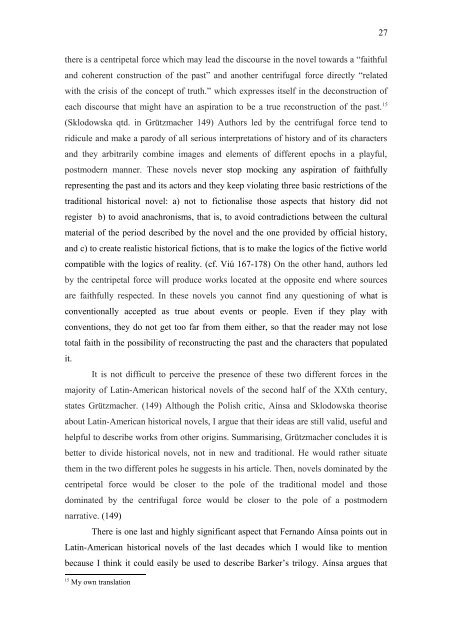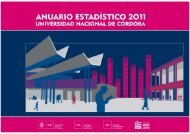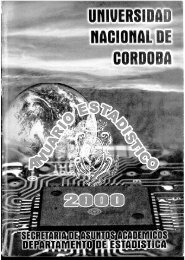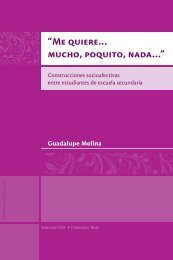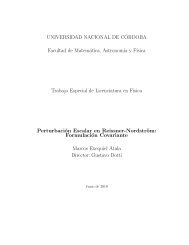26creative process, f) the novels are informed by the Bajtinian concepts of dialogism, thecarnivalesque and heteroglossy.In or<strong>de</strong>r to expand the discussion about historical novels, I would like to mentionan i<strong>de</strong>a <strong>de</strong>signed and sustained by Lukasz Grützmacher from Warsaw University,Poland. In his article “Las trampas <strong>de</strong>l concepto ‘la nueva novela histórica’ y <strong>de</strong> laretórica <strong>de</strong> la historia postoficial” published in Acta Poética (2006), he is very critical ofSeymour Menton’s <strong>de</strong>scription of the “new historical novel” and at the same time hecontributes to the topic with his own arguments.According to Grützmacher, the six features <strong>de</strong>signed by Menton to better<strong>de</strong>scribe the “new historical novel” are rather “superficial and consequently, <strong>de</strong>spitemaking some aspects clearer, on the whole, they bring more confusion into the picture.”(Grützmacher 144) He also asserts that it is quite unfortunate, in the first place, to callsomething “new” because in everyday language, what is new today it is no longer sotomorrow, and in terms of literary theory, “nueva novela” makes you think of the“nouveau roman” of the 50s. (Grützmacher 150) Furthermore, he thinks it is almostimpossible to make a clear division between novels and call them “new” or“traditional”. Why is this so? Because in novels <strong>de</strong>scribed as “traditional” by Menton,we can find features Menton himself <strong>de</strong>scribes as belonging to the “new historicalnovel” and also, many novels that are “new” in his opinion, are pretty close to theclassical version of the genre or they show the six characteristics in highly varied<strong>de</strong>grees. (Grützmacher 147) Grützmacher’s conclusion is that he would rather speak interms of two poles or extremes. He quotes Fernando Aínsa, literary critic from Uruguayand his article “La reescritura <strong>de</strong> la historia en la nueva narrativa latinoamericana” (cf.Aínsa 1991) In it, states Grützmacher, Aínsa observes two opposite ten<strong>de</strong>ncies whichare both present in contemporary historical novels: “on the one hand, we have textswhich try to re-create the past and its characters and on the other hand we have thosewhich <strong>de</strong>construct it.” (Aínsa qtd. in Grützmacher 148) The first ones use availablehistoriographic sources, the rest emerge from their authors’ free imagination. That is tosay, some texts will give rea<strong>de</strong>rs one more version of the past and historical data andchronologies will be faithfully transported into them, whereas some other texts will<strong>de</strong>construct the past and will purposely alter data and chronologies such as the freeimaginations of their authors may dictate. According to Grützmacher, this classificationcoinci<strong>de</strong>s with the two forces mentioned by Elzbieta Sklodowska in her book Laparodia en la nueva novela hispanoamericana (1991) He <strong>de</strong>scribes her argument that
27there is a centripetal force which may lead the discourse in the novel towards a “faithfuland coherent construction of the past” and another centrifugal force directly “relatedwith the crisis of the concept of truth.” which expresses itself in the <strong>de</strong>construction ofeach discourse that might have an aspiration to be a true reconstruction of the past. 15(Sklodowska qtd. in Grützmacher 149) Authors led by the centrifugal force tend toridicule and make a parody of all serious interpretations of history and of its charactersand they arbitrarily combine images and elements of different epochs in a playful,postmo<strong>de</strong>rn manner. These novels never stop mocking any aspiration of faithfullyrepresenting the past and its actors and they keep violating three basic restrictions of thetraditional historical novel: a) not to fictionalise those aspects that history did notregister b) to avoid anachronisms, that is, to avoid contradictions between the culturalmaterial of the period <strong>de</strong>scribed by the novel and the one provi<strong>de</strong>d by official history,and c) to create realistic historical fictions, that is to make the logics of the fictive worldcompatible with the logics of reality. (cf. Viú 167-178) On the other hand, authors ledby the centripetal force will produce works located at the opposite end where sourcesare faithfully respected. In these novels you cannot find any questioning of what isconventionally accepted as true about events or people. Even if they play withconventions, they do not get too far from them either, so that the rea<strong>de</strong>r may not losetotal faith in the possibility of reconstructing the past and the characters that populatedit.It is not difficult to perceive the presence of these two different forces in themajority of Latin-American historical novels of the second half of the XXth century,states Grützmacher. (149) Although the Polish critic, Aínsa and Sklodowska theoriseabout Latin-American historical novels, I argue that their i<strong>de</strong>as are still valid, useful andhelpful to <strong>de</strong>scribe works from other origins. Summarising, Grützmacher conclu<strong>de</strong>s it isbetter to divi<strong>de</strong> historical novels, not in new and traditional. He would rather situatethem in the two different poles he suggests in his article. Then, novels dominated by thecentripetal force would be closer to the pole of the traditional mo<strong>de</strong>l and thosedominated by the centrifugal force would be closer to the pole of a postmo<strong>de</strong>rnnarrative. (149)There is one last and highly significant aspect that Fernando Aínsa points out inLatin-American historical novels of the last <strong>de</strong>ca<strong>de</strong>s which I would like to mentionbecause I think it could easily be used to <strong>de</strong>scribe Barker’s trilogy. Aínsa argues that15My own translation
- Page 1 and 2: 1INTRODUCTION.Marcelo Figueras, Arg
- Page 3 and 4: 3CHAPTER 1. Theoretical considerati
- Page 5 and 6: 5Hassan continues saying that there
- Page 7 and 8: 7novels are then, the mise en scèn
- Page 9 and 10: 9well as the economic system depend
- Page 11 and 12: 11The following lines from What The
- Page 13 and 14: 13between a television commercial a
- Page 15: 15Raja 95-97) 5 Within this logic,
- Page 18 and 19: 18apocalyptic rhetoric of a Charles
- Page 20 and 21: 20In her doctoral thesis, Dr. Crist
- Page 22 and 23: 22of knowledge that strives to beco
- Page 24 and 25: 24is general with what is particula
- Page 28 and 29: 28“this is the most important cha
- Page 30 and 31: 30a vibration. It pushes against th
- Page 32 and 33: 32Odyssey would be for Joyce’s Ul
- Page 34 and 35: 34Still 22) Hypertextuality is a pr
- Page 36 and 37: 36qtd. in Allen 37) Here, Shelley t
- Page 38 and 39: 38decide whether they are examples
- Page 40 and 41: 40knowing subjects be it Barker or
- Page 42 and 43: 42him back to war, as “the Saviou
- Page 44 and 45: 44was the step daughter of a man wh
- Page 46 and 47: 46happened as it did. It was a prob
- Page 48 and 49: 48If you are creating you have hope
- Page 50 and 51: 50of nervous unbalance for which he
- Page 52 and 53: 52context of Barker’s novels. If
- Page 54 and 55: 54there at all. Burns, one of River
- Page 56 and 57: 56stock to the Army. Billy felt his
- Page 58 and 59: 58man who did not quite fit with hi
- Page 60 and 61: 60negative viewpoint about war. In
- Page 62 and 63: 62CHAPTER 3. The broken hero3.1 Bil
- Page 64 and 65: 64Then, in 1914, the war broke out
- Page 66 and 67: 66says Dr. Yealland, another real c
- Page 68 and 69: 68seem to be sufficient or strong e
- Page 70 and 71: 70we are gone they’ll lie about i
- Page 72 and 73: 72behaviour and even psychology, ve
- Page 74 and 75: 74‘What did you do before the war
- Page 76 and 77:
76private soldiers and not officers
- Page 78 and 79:
78Perhaps because he’d recently b
- Page 80 and 81:
80initially believed that the diffe
- Page 82 and 83:
82values and the disappearance of a
- Page 84 and 85:
84resentment. On one occasion when
- Page 86 and 87:
86‘I love you Sarah Lumb.’‘I
- Page 88 and 89:
88In order to do this analysis, let
- Page 90 and 91:
90Soldiers and officers were made t
- Page 92 and 93:
92Spiegel: So there is no such thin
- Page 94 and 95:
94these motives clashed with other
- Page 96 and 97:
96Let us go back to Prior now. I wi
- Page 98 and 99:
98part of life which has to be reco
- Page 100 and 101:
100problematic and multifaceted cha
- Page 102 and 103:
102Nothing stopped him from humilia
- Page 104 and 105:
104chooses the victim’s side and
- Page 106 and 107:
106incompetence of officers, the di
- Page 108 and 109:
108Modernism, (...) particularly it
- Page 110 and 111:
110intellectual honesty to be able
- Page 112 and 113:
112history is a continuum of which
- Page 114 and 115:
114Amorós, Andrés. Introducción
- Page 116 and 117:
116Grützmacher, Lukasz. “Las tra
- Page 118:
118Spargo, Tamsin (ed). Reading the


